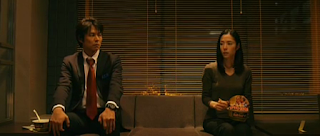Bayside Shakedown: The Movie 4; or, A New Hope
Don't mess with us cops...
Just in 2010, when the Odoru Daisousasen movie series was rebooted
and two years later it was announced that it’s coming to an end! The Last
TV special episode and Odoru Daisōsasen The Final: Arata Naru Kibō, filmed
back-to-back, mark the very last entries in the 15-year-old franchise.
Release Info
Directed by: Katsuyuki Motohiro Starring: Yuji Oda, Eri Fukatsu, Toshiro Yanagiba, Yusuke Santamaria
Language: Japanese Original Title: 踊る大捜査線 THE FINAL 新たなる希望 Runtime: 126 min
Synopsis
A gun is stolen from the evidence archive in the Tokyo
Metropolitan Police Department. Soon after, two people die from that gun in the
jurisdiction of the Wangan Police Station. Aoshima’s team begins the investigation,
but the HQ’s investigative unit led by Torigai (Shun Oguri) takes over. It turns
out that a cop stole the gun so, to hush things up, Muroi (Toshiro Yanagiba)
and Aoshima (Yuj Oda) are turned into scapegoats. In the meantime, Sumire (Eri
Fukatsu) considers quitting her job because of the inability to cope with
pain from a gunshot wound. WPS police officers join their forces to discover an
in-police conspiracy that has something to do with what Mashita (Yusuke
Santamaria) did in his early days as the negotiator.
All the good things...
Well, to be honest, Bayside Shakedown 4: The Final is a
decent, well-made conclusion to one of the most awesome franchises ever.
However, I guess that my expectations for this movie were a bit too high. In
a lot of ways, I enjoyed The Last TV special episode more, and it was only
lead-in to this final film. The uneven pacing is probably the only issue of
this movie as it starts right off the bat with the chase scene, crazy awesome
intro (my favourite out of all movies) and then it slows down to present a lot
of exposition intertwined with humor scenes.
Nevertheless, I also greatly enjoyed many things which this
film had to offer. The development of the Aoshima/Sumire (only friends!)
relationship was done way better than in the previous sequel. In
addition, the running theme of the series: excessive police bureaucracy is quite
interesting to watch as both Aoshima and Muroi become the victims of the
corrupt system. In addition, the conspiracy involving Mashita was really
gripping. At first, I thought that the creators were trying to be over-original
with the plot, but eventually, I appreciated that the crime had a little bit of
personal factor (with relation to the characters) conveyed in itself. All in
all, this is the final movie.
Speaking about performances, as in the previous movies, the Odoru
cast was remarkable. The highest praise goes to Eri Fukatsu as she did the best
job with her character since Bayside Shakedown: The Movie 2. Yuji Oda is great
as always as Aoshima and the same thing applies to Toshiro Yanagiba and his
portrayal of Muroi. Though, I hoped to see a little bit more of Muroi Shinji in
this movie. In addition, Ren Osugi reprises his cameo role from the first
theatrical film as a cover-up expert, the man behind the scenes who brings
down the top brass of the police force
Recommendations
If you liked the previous theatrical films of the series,
then this movie will not let you down. It may be uneventful at times, but
generally it manages to deliver the desired dosage of Bayside Shakedown
glamour. There’s humour, action, entertainment, and Aoshima running to the pumped
up "Rhythm and Police" theme song. What’s more important, the promise made by
Muroi in the last episode of the show has finally been fulfilled.
Well, this is the end of my two-month adventure with Odoru Daisousasen. It was a wonderful and unforgettable ride. I can only hope that someday, just maybe, there will be a new movie released.
Overall score: 8/10





















